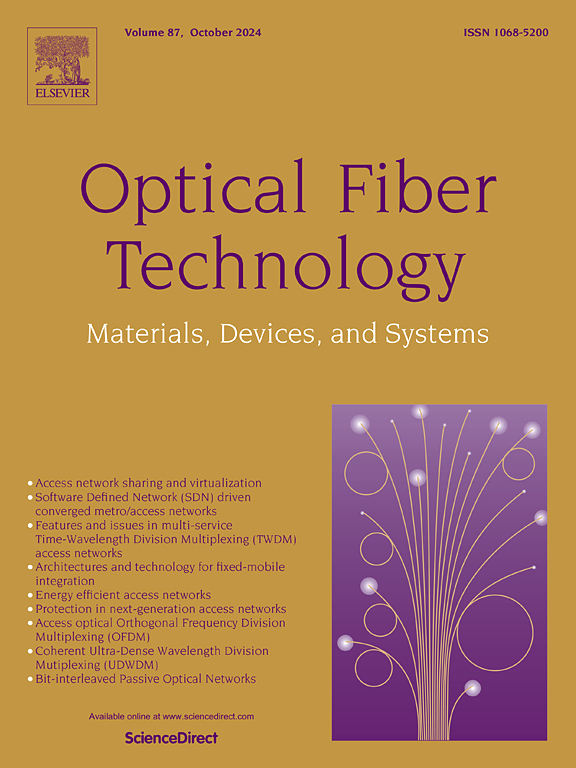碲化铋作为掺钕光纤激光器的无源 Q 开关
IF 2.6
3区 计算机科学
Q2 ENGINEERING, ELECTRICAL & ELECTRONIC
引用次数: 0
摘要
随着各种材料作为可饱和吸收体在近红外和中红外激光腔中的应用得到证实,光纤激光的研究进展非常迅速。不过,研究人员主要将掺铒、掺镱和掺铥光纤作为增益介质。在这里,我们提出了一种掺钕光纤激光器装置,用于产生 1-μm 波段的 Q 开关激光器。该激光器利用拓扑绝缘体碲化铋作为脉冲产生的 Q 开关。这种 SA 在 1089 nm 波长处的线性吸收约为 5 dB,可以在掺钕光纤激光腔中产生稳定的 Q 开关激光。当泵浦强度在 167 至 190 mW 之间调节时,它能产生波长为 1089 nm 的稳定 Q 开关激光。脉冲激光的最短脉宽为 6.48 μs,最大重复频率为 40 kHz。该激光器的信噪比为 40 dB,因此稳定性很好。据作者所知,这是首次在全光纤化掺钕光纤激光器腔中使用碲化铋作为可饱和吸收体。本文章由计算机程序翻译,如有差异,请以英文原文为准。
Bismuth telluride as a passive Q-switcher for neodymium-doped fiber laser
The scene of fiber laser has progressed very rapidly with the demonstration of various materials as saturable absorbers in a near- and mid-infrared laser cavity. However, the researchers focused on erbium-, ytterbium-, and thulium-doped fiber as a gain medium. Here, we proposed a neodymium-doped fiber laser setup to generate a Q-switched laser in a 1-μm regime. The laser utilized bismuth telluride, a topological insulator as a Q-switcher for pulse generation. With a linear absorption of approximately 5 dB at 1089 nm, this SA can generate a stable Q-switched laser in a neodymium-doped fiber laser cavity. It generates a stable Q-switched laser at 1089 nm when the pump intensity is adjusted between 167 and 190 mW. The pulsed laser owns the shortest pulse width of 6.48 μs with a maximum repetition rate of 40 kHz. The stability of the laser is promising since it has a signal-to-noise ratio of 40 dB. In the authors’ knowledge, this is the first demonstration of bismuth telluride as a saturable absorber in an all-fiberized neodymium-doped fiber laser cavity.
求助全文
通过发布文献求助,成功后即可免费获取论文全文。
去求助
来源期刊

Optical Fiber Technology
工程技术-电信学
CiteScore
4.80
自引率
11.10%
发文量
327
审稿时长
63 days
期刊介绍:
Innovations in optical fiber technology are revolutionizing world communications. Newly developed fiber amplifiers allow for direct transmission of high-speed signals over transcontinental distances without the need for electronic regeneration. Optical fibers find new applications in data processing. The impact of fiber materials, devices, and systems on communications in the coming decades will create an abundance of primary literature and the need for up-to-date reviews.
Optical Fiber Technology: Materials, Devices, and Systems is a new cutting-edge journal designed to fill a need in this rapidly evolving field for speedy publication of regular length papers. Both theoretical and experimental papers on fiber materials, devices, and system performance evaluation and measurements are eligible, with emphasis on practical applications.
 求助内容:
求助内容: 应助结果提醒方式:
应助结果提醒方式:


